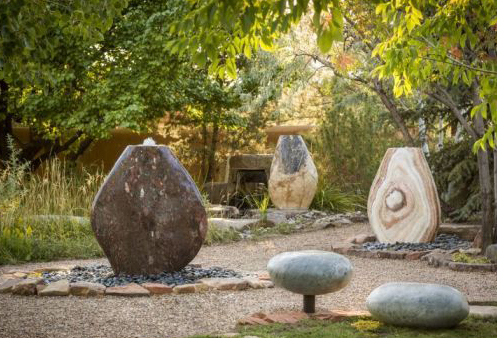garden ornaments
'When I paint,' observed Stephanie Rose at the start of her Natural Companions column in October 2006, 'I constantly play with color on canvas and experiment with various combinations to see what works well and discover what, to my eye, clashes or doesn't seem to mix harmoniously.' 'As a landscape designer, I'm aware of working through the same sort of
Stone Forest (Santa Fe, NM) now produces The Pebble Collection, a product line inspired by…
Avalon Fountains (Malibu, CA) has published a digital catalog covering its line of nature-inspired fountains…
Haddonstone (Mount Laurel, NJ) manufactures the Athenian Wall Fountain. Part of the Athenian Collection of…
One of the compliments we appreciate most at Root Design Co. is when people say that no two of our projects look alike. Indeed, we pride ourselves on being able to work effectively across a broad spectrum of styles and use both time-tested and innovative building methods in ways that let us focus on details and on making certain we’re always generating work that speaks directly to our clients’ unique tastes and desires. To maintain our edge, we limit the number of projects we tackle each year and, at the same time, seek out clients whose enthusiasm matches our own when it comes to pursuing
With every new project, we always strive to create unique watershapes that reflect particular clients’ wants, needs, dreams and imaginations. What this means, given the fact that every client is an individual, is that no two of our pools are ever quite the same. In the case described in this article, for example, the clients’ distinctive personalities led us to create something that’s more like a waterpark than a residential pool/spa combination. In a very real sense, it reflects their personalities and a sense of the magic they find in certain chapters of our history – a special space for them to enjoy with their children. The clients purchased the newly built home on a hill overlooking the ocean in
When I was a kid, the conventional part of my education in environmental design came in helping my father, Jay Stang, plant parkways and blocks of Pinus Pinea across the city. The unconventional part - the part that apparently took firmer root as I grew up - had me admiring the plate he'd made from hardwood with the dozen split avocado pits he'd carved and mounted on the surface; it also had me listening to my mother, Judy Campbell, tell me that the earth was here first, that the garden already exists and that pathways, watershapes and structures are best built around what we find there. Those unconventional lessons - one about creativity and vision, the other about respect for nature and a method for approaching it - have stayed with me through the years and have given me access to a number of incredible projects. As is the case with most intriguing and fascinating designs, the one seen here flowed from a client with whom I developed a close creative connection that resulted in a free exchange of ideas¬ - a synchronized spontaneity that became a pattern for the entire design process. She always had strong thoughts about what she wanted, but she allowed me to interpret and express her ideas based on our conversations and the nature of the site. As designers, it's not unusual for us to be called on to use our skills and figure out what a client such as this one really wants and then suggest ideas we think will work. I call this process "environmental psychiatry" because, while so many clients have a sense of what they want and a laundry list of general ideas, few have a
When I was a kid, the conventional part of my education in environmental design came in helping my father, Jay Stang, plant parkways and blocks of Pinus Pinea across the city. The unconventional part - the part that apparently took firmer root as I grew up - had me admiring the plate he'd made from hardwood with the dozen split avocado pits he'd carved and mounted on the surface; it also had me listening to my mother, Judy Campbell, tell me that the earth was here first, that the garden already exists and that pathways, watershapes and structures are best built around what we find there. Those unconventional lessons - one about creativity and vision, the other about respect for nature and a method for approaching it - have stayed with me through the years and have given me access to a number of incredible projects. As is the case with most intriguing and fascinating designs, the one seen here flowed from a client with whom I developed a close creative connection that resulted in a free exchange of ideas¬ - a synchronized spontaneity that became a pattern for the entire design process. She always had strong thoughts about what she wanted, but she allowed me to interpret and express her ideas based on our conversations and the nature of the site. As designers, it's not unusual for us to be called on to use our skills and figure out what a client such as this one really wants and then suggest ideas we think will work. I call this process "environmental psychiatry" because, while so many clients have a sense of what they want and a laundry list of general ideas, few have a



















